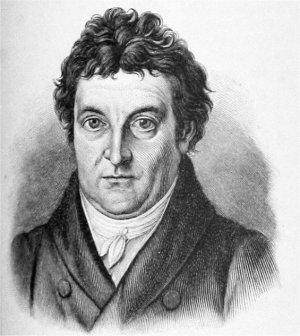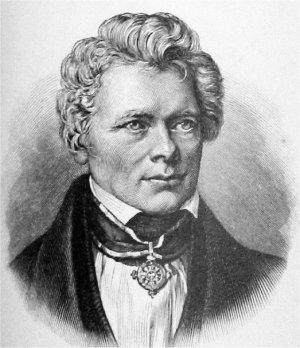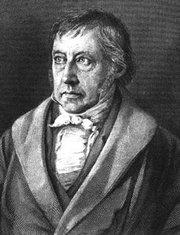The 19th
Century:
Idealism &
Positivism
What is really real
— and where is it located?...
|
Think of this as a discussion of majority and minority
opinions.
|
|
The “dominant” view, held by most people in the
19th century is Idealism, pretty much an elaboration
of the Rationalist line of Modern thought, pretty much associated
with a number of main-line German philosophers. As usual, three
of them: Fichte, Schelling and Hegel; as usual, one of ‘em
(Hegel) developed a line that was considered provocative by
another (Schelling — and just about everyone else,
including the government...); neither Schelling nor Hegel liked
Fichte, who was (in a sort neat, retro way) regarded as a
(religious) heretic. Generally, Idealism locates the really real
in the construction of the universe from a constellation of
sensible impressions.
|
|
The opposing “minority opinion” took one form or
another of a Realism — in this instance, the idea that, to
some extent or other, there is that, independent of the
constucting mind, which is completely real, can be measured to
some extent, and can be meaningfully described and manipulated
within limits.
|
|
By far the most influential of these views is Idealism.
|
Idealism
Idealism, in general, takes the view that what we call the world,
or the universe (whatever) is a constellation of events in our
experience. This can be asserted in a stronger way — this is
to deny any knowledge of an outer reality at all. This would be the
most extreme sort of Cartesian view, and the late-19th
century actually produced folks of this sort, for whom ordinary
experience was simply wrong. All that was really real, was our
construction of a universe from our experiences; assertions about any
sort of actual reality independent of our individual minds was simply
doubtful. Interestingly, just about every name I can associate with
such views is that of a person known to be pretty twitchy, but there
you are. Let’s call this extreme Idealism an ontological
Idealism: Ideas are (that is,
they are in some sense beings, ta
onta).
There is a less extreme form of Idealism; let’s call it
metaphysical Idealism. It entails an ontological Realism,
used not as this term is used in ancient and mediæval
philosophy; here we mean, there really are entities, things that are
in themselves, ta onta,
existing independently of our thinking about them. This is Kant’s
phenomena/noumena distinction, noted before. Basically, while there
are things that exist independently of me, I can know them only as
they are present to me in consciousness, under some sort of structure
of the mind or whatever. That is, Idealism is merely a way to
explain how there is something rather than nothing to me,
and how it is possible for me to know it.
Both these mainline possibilities are
inherent in Modern philosophy from its inception more or less at the
outset of the 17th century. Variant precursors are easily
found in all the main thinkers we have mentioned. Kant is usually
considered the person who makes clear the fundamental distinction (at
least; people have been claiming to find holes big enough to drive an
18-wheeler through pretty much since Kant published the Critique
of Pure Reason [a/k/a “the first Critique”; there are
two more...]).
German Idealism
|
Kant’s younger contemporary —
say, “GenX” to Kant’s “GenB-for-Boomer”,
Johann Gottlieb Fichte, is generally considered the first of the
Big Name German Idealists. Kant thought Fichte was an All Right
Guy initially, developing the Kantian line, but rescinded that
approbation later; Fichte was doing something pretty much on his
own. Fichte’s idealism took the extreme form, and not
surprisingly, Fichte seems to have been a bit twitchy (indulge in
some pop-psychology; look at the picture...).
Fichte
is really much better known for his Addresses to the
German Nation. Even today,
this is what is generally read by undergraduate philosophy
students encountering Fichte for the first time, and few get
beyond that. In his own time, Fichte was dismissed from his
university post for political and religious failings.
|

Johann Gottlieb Fichte
|
|

F.W.J.
Schelling

G.
W. F. Hegel
|
Schelling and
Hegel were contemporaries, “GenY” to Fichte’s
“GenX” if you will. They are both protestant, both
from southwest Germany — an interesting part of the
country, known for a certain independence of thinking that is not
a commonplace German national characteristic (we don’t
believe in “nationaler Eigentumlichkeiten”
much these days, but they were taken for granted until, O, 60
years ago or so).
Both Schelling and Hegel are protestant. This is very
important (and not a little odd, when you consider that some of
the most convinced followers of German Idealism today seem to be
Roman Catholic). Both studied at the university in Tübingen
(along with the great Romantic poet, Hölderlin; Idealism and
Romanticism walk hand in hand), in the protestant theology
faculty. [Today, at least, there is Roman Catholic faculty as
well; the two are housed in the same building, with wall down the
middle. I do not know if the Tübingen theology faculty
embraced both sides of the Reformation at that time, though I
would not be surprised; a number of the noble families of
Württemberg seem to have remained papist, while the rest of
the folk were largely Lutheran.
Hegel
is the biggest of these Big Names. He was the scariest of them
all to the Establishment (Schelling, by contrast, was accepted as
Orthodox, Right-thinking and generally pro-Establishment). He is
also the one who has always excited
young minds, and turned them toward philosophy. This was true in
his own day (students took verbatim notes of Hegel’s
lectures, and a lot of what survives as written-by-Hegel, is
really reconstruction from such notes). It is true today; I have
seen large classrooms filled to overflowing, with students
spilling out into hallways — respectable doctoral students
(well, perhaps not exactly respectable...) — sitting on the
floor to get the latest word on Hegel’s philosophy. The
Young Hegelians filled out the philosophical system. The St.
Louis Hegelians, in the United States, elaborated an American
version (and one of them built the Brooklyn Bridge; Hegelians
still come to admire its perfect philosophical structure...).
Karl Marx and his followers elaborate from it a whole new
political philosophy (which is very probably inherent in the
basic Hegelian thinking, and which rests entirely on Hegel’s
notion of the historical unfolding of the Spirit in a dialectic).
|
[Interestingly,
Hegel himself seems to have abandoned — or never to have been
interested in — any sort of radical political thinking. His
book, Elements of the Philosophy of Right,
was puzzling to the young radical element when it appeared; its
acceptance by an “orthodox” group, historically less
significant than the Young Hegelians and Marxists, made that
orthodoxy acceptable to the politically conservative Establishment
that ran the entirely state-controlled universities, and to the
hierarchies of both Protestant (especially, Lutheran) and Roman
Catholic state churches that predominated until the end of the second
decade of the 20th century. That same line has been
influential in conservative political thinking in the United States.
It was the prevalent line of Continental thinking tolerated at
Harvard University (not, of course, in the Philosophy Department,
which was mired in Pragmatism and Anglo-American linguistic-analytic
folly, but in the study of government and politics); it clearly drove
the thinking of Henry Kissinger, and still lurks in the background of
those who align themselves with that conservative politics.]
The
great work of Hegel is The Phenomenology of the Spirit.
It is not an easy book, and it is even worse at the beginning. The
preface was written, so the story goes, overnight, since Hegel was
late with the manuscript. He was clearly over-tired, and he clearly
never edited. Add to this a tendency for the German language to
allow over-long sentences, and the difficulty of German syntax (the
general rule: Find the verb!), and the thing is just about
unreadable. The rest of the book is far less awkward, as I recall.
Far more interesting, and infinitely more readable, in my view, is
the Encyclopedia of Philosophical Sciences.
|
§ 1.Objects
of Philosophy
§ 2.Reflective
Thought
§ 3.The
Content of Philosophy
§ 4.Popular
Modes of Thought
§ 5.Reason
§ 6.All
that is Rational is Real
§ 7.Beginning
to Reflect
§ 8.Empirical
Knowledge
§ 9.Speculative
Logic
§ 10.The
Critical Philosophy
§ 11.Conditions
for the existence of Philosophy
§ 12.The
Rise of Philosophy
§ 13.The
History of Philosophy
§ 14.The
System of Philosophy
§ 15.Each
of the parts of philosophy is a philosophical Whole.
§
16.The
form of an Encyclopaedia
§ 17.How
to Begin?
§ 18.Subdivision
of philosophy into three Parts
|
This is the list of sections, in the introduction to part one
of the Encyclopedia,
sometimes called “The Encyclopedia Logic” or “The
Shorter Logic” (to distinguish it from The
Science of Logic, which is
Hegel’s complete treatment of the subject).
This is very short — about
the length of a 10-page typed-double-space manuscript. The
paragraphs are short, the translation is felicitous and I think
you should read it. Hit the hyperlinked first section, and you
get the whole thing.
Far better to get the stuff right
from the horse’s mouth, than from me at second-hand.
|
The key elements to note here: First, philosophy is never grounded
in the same way as other sciences, in certain assumptions about how
knowledge works. It begins in the critique of that — how is
knowledge possible in the first place? This is the Cartesian
starting point, and that of everyone since. Second, philosophy is
systematic; it aims at a completed structure, from foundation
principles, to uttermost inferences. This is a superb summary of the
Rationalist line of thinking.
It is deemed completely absurd by quite a few folks, such as
Schopenhauer (a very hard philosopher to read). He is attacked by
many as politically authoritarian (possibly true, and certainly
understood as such by some later thinkers who assimilate him to both
authoritarian and totalitarian lines of thinking the 20th
century); he is defended by others (generally, by those who favor
nice Biedermeier authoritarian regimes — Marxists,
Leninists, proponents of Mao Tse Dong thought, and most Republicans
in the U. S., if they are smart enough to read Hegel).
Positivism
Positivism arises in the mid-19th
century, and we need to look at it briefly. All Modern science, from
1850 on, roughly, is positivist. Edmund Leach, in his 1966 Henry
Myers lectures, defines Positivism:
|
Positivism
is the view that serious scientific inquiry should not search
for ultimate causes deriving from some outside source but must
confine itself to the study of relations existing between facts
which are directly accessible to observation.
|
This is exactly the opposite of what Rationalist and Idealist
philosophy has been claiming about scientific knowledge. It is the
ultimate Empiricism. The problem that Hume notes, of cause and
effect as the primary relationship, is not resolved nor dissolved —
it is just ignored (except by some philosophers of science).
The great name associated with Positivism initially is that of
Auguste Comte. His aim seems to have been mostly to develop a social
science that paralleled the advances of natural science. He was not
particularly successful. However, this is a very good label for what
is accomplished for the first truly Modern social science that is
a science as we understand that today, in the hands of John Stuart
Mill.
Effectively, Mill (who was an accomplished Utilitarian moral
philosopher, as well as the founder of scientific economics) says,
that which in economics can be treated quantitatively and
mathematically, can be considered “science”; the rest is
philosophy. This is important because it distinguishes between
philosophy and science (a very new idea), and it asserts the
mathematical nature of science. Since quantification in economics
(and social science generally) is a matter of ratios and of
incremental change in statistical populations, the heart of the
matter is the Calculus (and that is why you study calculus and
statistics, if you do social science). Mill actually solves some of
the ultimate-causes problems this way; mathematics is a well-founded
system. But, while Mill is smart enough to get that, it is far from
clear the average run of positivist natural- or social-scientist even
gets it. And that can be a problem.
Logical-positivism, which aims at extending this inherent foundation,
by looking at the larger logical issues that can be adumbrated from
mathematical and quantitative approaches to science (mathematics,
after all, is just a special case of a logical system), develops in
Vienna, and is taken to England in the early 20th century,
where it eventually supplants British Idealism in the universities,
and from there it spreads to the U. S., becoming increasingly
identified as an Anglo-American school.
We have covered most of the stuff I need to cover in the history of
how we got here, philosophically. In the next section, I will
comment on developments in the 20th century, which has led
to some of us thinking Modernity has gone about as far as it can go,
and is perhaps already past, with a view to asking, what is possible
to “post-Modernity”?
You should be finishing your research for your long papers. You
should have completed that reading in a week or so. You should then
spend a week thinking and reviewing that material, then set about
writing a few pages a day, over the ensuing week.
I expect I will write your
examination next week, then generate the prep-sheet page, with essay
questions and general review guidelines.


